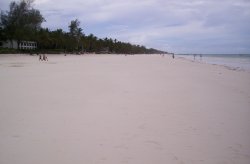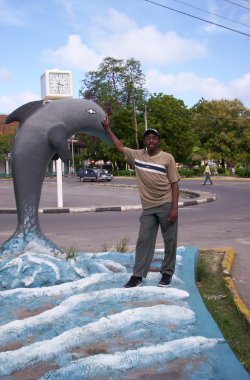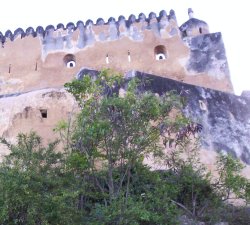|
TOURISM
IN KENYA
Great Rift Valley
Beautiful
countryside
Hotels
& Lodges
Kenya's
Coast >
Economy
Government
Kenya
National
Parks
Lake
Victoria
The
People of Kenya
Wildlife

Diani Beach, on Kenya's south
coast near Mombasa.


Fort Jesus was built by the
Portuguese in the 16th century. It is now a museum.

The town of Mombasa is almost 1,000 years old but modern influences are
also present. The above is an office building on Nyerere Road.
LINKS
|
Kenya's tropical
Coast
The coast of Kenya, on the
tropical shores of the Indian Ocean, stretches from Lamu near the
Somali border running south west to meet Tanzania at a small town
called LungaLunga.
Mombasa is the local administrative, cultural and economic capital. The
town is an offspring of the Indian Ocean trade that has thrived for
thousand of years. The trade, driven by monsoon winds blowing over the
sea, served to attract business people from China, Malaysia, India,
Persia and Arabia.
Influences from Arabia, India and from Europe can be seen throughout
Mombasa in form of churches, mosques, living quarters, ports and
fortresses. The biggest fort, Fort Jesus, was built by the Portuguese
in 1593 to defend Mombasa Island. Today the Fort hosts a museum where
visitors can be shown canon and dungeons. The Mombasa Old Port and Old
Town are still centers of Afro-Arabic culture. Wooden ships, called
dhows, continue to sail from here to other East African towns such as
Malindi, Lamu, Dar es Salaam and Zanzibar.
South of Mombasa, towards the Tanzania border, is the Shimba Hills
National Reserve which is home to the Sable antelope, lion, elephant,
buffalo, leopard, serval cat and others. (Tidbit: the serval cat is not
really a cat, it’s a rodent.) East of Shimba Hills, on the shores of
the Indian Ocean, can be found the Shimoni caves. These sad relics of
the slave trade were used as holding cells where captives were shackled
while awaiting ships bound for the Middle East and the Zanzibar slave
market.
On a more pleasant note, the area is alive with abundant marine life
thriving on coral reefs. Starfish, sea urchins, sera flowers and
turtles are some of the marine life to be seen. Big game fishing is a
growing sport and catches often include black, blue and striped marlin,
tuna and mako sharks
Big game fishing and the viewing of coral wildlife extend all the way
to Malindi, north or Mombasa. The waters there are protected by the
Watamu Marine National Park, one of the biggest in Africa. Near Malindi
again, lie the ruins of an ancient mythological city known as Gede. Its
believed that Gede may have grown during the height of the Indian Ocean
trade sometime in the Middle Ages. It is not clear why the town’s
population left hurriedly.
Further north, close to the border with Somalia, can be found the
islands of Lamu and Pate, which have been centers of Arabic influence
on the coast for many centuries. Significant numbers of Europeans have
settled permanently on the islands, no doubt drawn to the tropical
beaches, moderate climate and open-hearted people.
Still in the coastal region, the Tana and Athi rivers drain themselves
into the Indian Ocean. The two rivers are Kenya’s most important. The
Tana river delta is a zone of untouched wilderness which requires prior
arrangements as tourist facilities in the area are few and far apart.
Occasionally, foreign military forces make use of the Tana delta for
survival training.
Two hours drive west of Mombasa, at a higher and cooler altitude, can
be found the Taita Hills, which are the remains of extinct volcanoes.
Jagged rocks protrude out of thick forest, yet man has been able to
adjust to life on its foothills for hundreds of years. The Taita Hills
give way to the expansive plains of the Nyika – an extremely harsh
landscape of dust, bush and wildlife, stretching far into the
horizon.
Top
|






